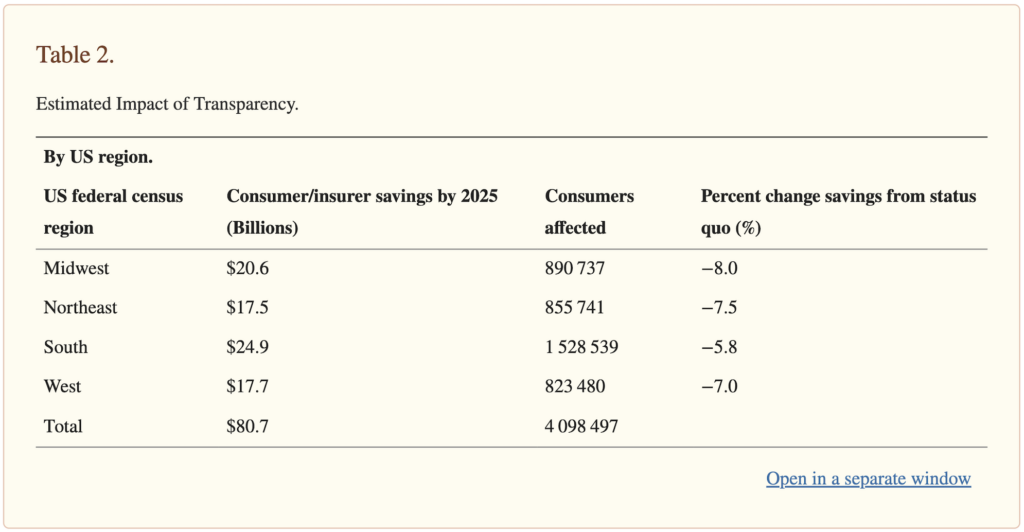This post originally appeared at https://will-law.org/wi-patients-stand-to-benefit-most-from-healthcare-price-transparency/
By Miranda Spindt
Healthcare costs have continued to rise and become a top concern, putting a strain on individuals and families. But a recent analysis by Dr. Stephen Parente from the University of Minnesota has provided some encouraging news. The study reveals that lower-income individuals stand to benefit significantly from increased healthcare price transparency, with a meaningful decrease in healthcare costs. This analysis reaffirms the positive impact that greater price transparency can have on the lives of all Americans, and Wisconsinites especially.
The regional impact of price transparency legislation found in the study is particularly noteworthy. According to Parente’s analysis, the Midwest region is set to be the most substantial beneficiary with a potential $20 billion in savings and an 8% reduction in medical expenditure. The first table shows the estimated cost reduction for each region. This would be a great improvement in Wisconsin where the cost of healthcare is a large concern.
- A recent study by the RAND Corporation indicates that Wisconsin’s hospital prices are the 4th highest in the nation.
- A 2020 survey of Wisconsinites found that almost half of Wisconsinites—47%— have delayed or completely avoided receiving healthcare.
- Four in five Wisconsinites are worried about being able to afford our healthcare costs in the future, and 73% of respondents said healthcare was the most important issue to them.
- A study by Forbes found that healthcare costs in Wisconsin are nearly $10,000 per person each year.
- In Wisconsin, a blood test for clotting time can range from $17.50 to $135.47 and a joint replacement (hip or knee) can cost between $17,513 and $65,927.

Stephen Parente’s analysis also suggests that price transparency can be a game-changer for those at the lower end of the income spectrum. With a reduction of 7.4% for individuals earning less than 100% of the Federal Poverty Level, and 7.5% for those earning between 100% and 137% of the Federal Poverty Level, these findings underscore the potential for substantial savings. The very people who often struggle to make ends meet and face the toughest financial challenges are the ones who stand to benefit the most from this legislation. According to the U.S. Census data, 11.3% of households below the poverty level have high medical debt compared to 3.4% of households above the federal poverty level. The table below shows the estimated benefit for the remaining income levels.

The Trump Administration introduced federal price transparency rules in 2019 that require hospitals to post the prices of 300 shoppable services in a consumer-friendly format and the standard charges of all items and services in a machine-readable file. The Biden administration continued this rule and strengthened non-compliance penalties in 2022. However, only 36% of hospitals nationwide, and 49% in Wisconsin, are complying.
We know that price transparency works. New Hampshire was a pioneer in providing pricing information to consumers, with a website that predates the federal rules and offers estimates on over 120 procedures. A 2019 study by the University of Michigan and National Bureau of Economic Research found that patients saved $7.9 million, and insurers saved $36 million, in the first year of implementation. A 2019 study by WILL compared each state’s level of healthcare transparency with measures of healthcare affordability. The study found that greater transparency had a statistically significant effect on lowering healthcare costs. This study further confirms the benefits we should expect from full implementation of federal and state rules.
In Wisconsin, Senate Bill 328 would codify the federal price transparency rule in Wisconsin and authorize the state’s Department of Health Services to enforce it. This bill mirrors the federal rule, so hospitals in compliance with the federal rule would also comply with the state law. Today, there are about 33 states that have implemented some kind of price transparency law, many of which were passed by bipartisan coalitions. While price transparency is not a silver bullet to fixing our healthcare system, we know that it works and can bring significant cost-savings for patients. This is an important first step towards stalling, and possibly reversing, the rising costs of healthcare and the recent data shows that Wisconsin would be poised to benefit greatly from such a move.

Miranda Spindt
Policy Associate
Miranda@will-law.org
The post WI Patients Stand to Benefit Most from Healthcare Price Transparency appeared first on Wisconsin Institute for Law & Liberty.